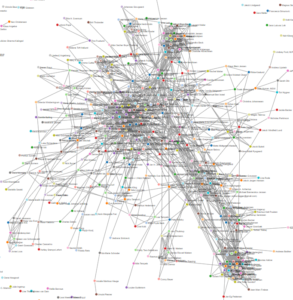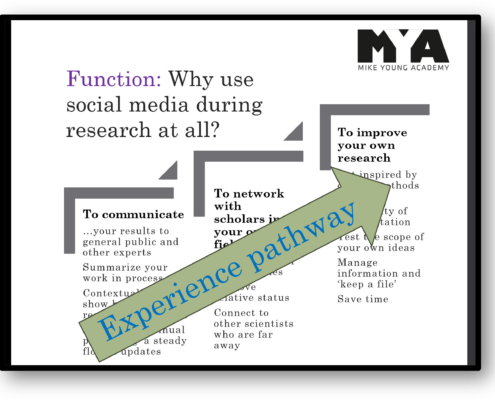Ethics part 2: Why do scientists use social media?
Part two in a four part series on the function, self-care, and ethics of scientist social media use.
Scientists use social media for a reason. They fulfil certain professional functions. In this post I want to look at these functions as a first step before I look at the self-care and ethical dimensions of them. You can read my introduction to this series here.
The way I see it, there are three overarching functions:
- Communication
- Networking
- Ideation
Let us look at each of these in detail:
Communication – to let others see your work
Social media can be used to get your self, your research process, and your results, seen.
Let us call this the communication function.

Social media platforms allow you to better control your ‘networking pathway’.
By posting on social media, your working self is visible to your peers, your stakeholders, and the general public: Your peers are your fellow scientists, in and outside your own field. Your stakeholders are non-scientists working in areas that are somehow related to your work, like people working for a funding agency, your university, a lobby group or politicians. The general public is a term that covers anyone outside these groups — meaning all of the good people out there who are interested in your work.
It is a good thing when the actual process, rather than just the result of your work, is seen by others — and social media are good at this. They are designed to show people in action.
Posts that show actual work in process allow your peers, your funders, and the general public to look over your shoulder and see science unfolding before their eyes. It invokes their curiosity, and it has the positive side effect of making you more approachable to people outside your field.

Why use social media in research at all? The staircases diagram above summarizes some of the key social media functions
Finished research, in the form of links to published scientific articles and papers, is also often posted to social media. And studies in multiple fields show that there is a higher chance of published work being cited if a link to it is at the same time posted on a social media platform. This seems intuitive, as there is a higher chance that other scientists will be inspired by your work, if they have seen it via their peers’ interactions with it on social media. I collaborate with other experts on workshops where we show scientists how to strategically use routines for quality reporting, open access publishing and preprints, as well as social media, to better promote research.
What about the general public?
Media organizations used to have a gatekeeping monopoly over what the public sees in terms of science. Social media have enabled a democratization of this process: Media no longer solely decide which scientists, or which science, is accessible to the wider public. In fact quite the opposite takes place: Media coverage can sometimes lag behind the general public’s scientific conversation by simply acting as echo chambers for trending scientists on social media.
With social media, you don’t have to play (or compete in) the traditional media game at all
My own career background has been in media. My goal as a journalist and editor was to reach a large numbers of interested readers, and keep them coming back for more. In terms of science, however, curious readers are a diverse bunch. They are often interested in very specific things. With the advent of social media, you as a scientist can reach the readers who are specifically interested in your work. You don’t have to play (or compete) in the traditional media at all.
Networking – meeting scholars in your own field
Scientists also use social media to network with others.
We meet new people all the time. And we would meet new people even if there were no social media.
But social media platforms allow you to strategically focus your networking pathway and thereby deliberately select other new people you want to meet. They also allow you to subsequently confirm (via say a ‘connection’ or a ‘follow’) your in-person, real life meetings, thereby increasing the chance of future interactions.
‘Scientific Twitter’ allowed scientists to jump in and out of a permanent, ongoing conversation within their own field
This is why the social media platforms are here to stay in science. They allow scientists to easily get an overview of who it is that is working on their specific field throughout the world. This, in turn, allows them to exploit the social phenomenon called the ‘Strength of Weak Ties’.

The weakest links may be the most effective. Graph of my own social network on Linkedin from the now defunct Socilab.com.
The Strength of Weak Ties phenomenon explains why scientists who are institutionally, academically and geographically far away, can be more valuable to you in a networking sense than the scientists who are close by. This is counterintuitive, but can be explained like this: Someone far away, in a different field, is also someone outside your social horizon. A connection to this person — a ‘weak tie’ — gives you a more fruitful access to a whole new set of connections, ideas and opportunities. People with stronger institutional, academic and social ties to you tend to only reinforce connections, ideas and opportunities that you have already.
Especially the former Twitter (now X), in a phenomenon called ‘scientific Twitter’, allowed scientists to jump in and out of a permanent, ongoing conversation within their own scientific field. It was the ultimate enabler of weak ties, and a huge scientific conversation that ultimately helped advance science and scientists.
Ideation – to improve your research quality
Scientists use social media to join their peers in a scientific conversation. By doing this they hope to be inspired by colleagues within their specific field and interest.
By using social media in this way you are, metaphorically speaking, uploading and downloading your own thought processes to and from the big emergent scientific ‘cloud’ up in the sky. Every morning, you might open your X account to see what your colleagues are doing throughout the world. After commenting and offering your own ideas, you jump off the platform and do your own work, and then return later in the day to the platform to ask your peers another question.
Social media platforms allow you to strategically focus your networking pathway
Sometimes you are inspired by others’ methods, sometimes you yourself are the source of inspiration to others.
Either way, you are using the platforms to help you along your own scientific thought pathway and test the scope of your own ideas.
Scientists are sometimes members of what I call ‘communities of interpretation’. This means that they use a platform to interpret a scientific object, like a picture, graph, table or infographic. Maybe you are part of a group of vets in a veterinarian group on LinkedIn that discusses pictures of sick pets? Or maybe you are a part of a group of cardiologists that discusses pictures of electrocardiograms? These groups are spontaneously emerging communities of interpretation that the platforms have enabled.
Scientists also use social media to manage their own information environment. By being a part of a research community on X, for example, you keep abreast of developments within your field. A ‘like’ or a retweet on X can be a way to ‘keep a file of something for later’ – a way of taking a note so that you can return to it later in the course of the day.
As scientists gain experience … they increasingly move away from thinking of social media as purely something to do with communication …
Finally scientists use social media to save time. Social media like LinkedIn are huge directories of contact details and skills. Less time is therefore spent on updating email addresses and contacts, and when you need to get hold of someone, or a group of people, social media allow you to do this also. On X, for example, the ‘circle’ function allows you to focus a tweet on a specific named group of people – perfect for quickly making people aware of a talk or event.
Experience shifts you towards networking and ideation
Now let me tell you something interesting.
I sometimes start my workshops by asking participants why other scientists use social media. I have also regularly asked the same question to a series of social media practitioners in interviews for my blog.

As scientists gain experience on social media, they assess it as being more valuable in its networking and ideation functions
Scientists who are inexperienced on social media tend to respond that other scientists use social media to communicate.
Scientists who have some experience on social media tend to respond that other scientists use social media to network.
Scientists who have the most experience and who consider themselves superusers also tend to respond that other scientists network. But they also respond that other scientists use social media to to improve their own research, and help with their own ideas: To ideate.
So now we have another dimension to the table and typology that I am making: Social media experience.
As scientists gain experience and find a social media routine that works for them, they increasingly move away from thinking of social media as purely something to do with communication of their work. Instead, they think of social media in terms of meeting interesting people and improving their own ideation processes and research.
Feedback appreciated!
My introduction to this series is here: Social media ethics for scientists – setting a new standard.
You have just read this second part covering the basic functions of social media for scientists, where I unfold my tripartite model. Scientists use social media for three main reasons: It helps them communicate, network with others, and get inspired or ideate.
My third post in the series is about the self-care approach to scientists’ social media use on each of these three dimensions. How can scientists exploit social media without getting exploited by the platforms?
My final post (coming up!) will take on ethical obligations. What are the ethical grounds for social media use as a scientist? How can we use social media as a power for the good, and without harming others?
I hope you will read and reflect with me! And I appreciate any comments or thoughts!
Does your department, faculty or university need to boost the international impact and career of your researchers? Here is more about my courses in social media for researchers. See other Mike Young Academy services here.




Leave a Reply
Want to join the discussion?Feel free to contribute!